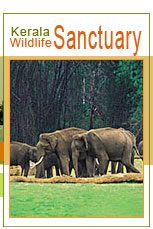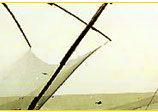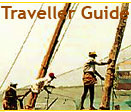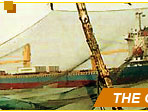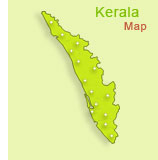¤¤ Tourist Attractions
A leisurely walk through the city is the best way to discover historic Fort Kochi. An obscure fishing village that became the first European township in India, Kochi has an eventful and colourful history. The town was shaped by the Portuguese, the Dutch and later the British. The result of these cultural influences are seen in the many examples of Indo European architecture that still exist here.
Vasco da Gama Square The huge cantilevered fishing nets are the legacy of one of the first visitors to the Malabar Coast. Erected here between 1350 and 1450 AD by traders from the court of Kublai Khan, these nets are set up on teak wood and baboo poles. The best place to watch the nets being lowered into the sea and catch being brought in is the Vasco da Gama Square, a narrow promenade that runs along the beach. The Square so an ideal place to idle, with stalls serving fresh delicious seafood, tender coconut etc.
Pierce Leslie Bungalow A representative of the Fort Kochi colonial bungalow, this building reflects Portuguese, Dutch and local influences. Characteristic features are wood panels that form the roof of the ground floor, arched doorways, carved doors and sprawling rooms. Waterfront verandahs are an added attraction.
Old Harbour House This elegant old bungalow built in 1808 is in the possession of Carrit Moran & Co., renowned tea brokers, who now use it as their residence. The house was once a boat club.
Koder House This magnificent building is a supreme example of the transition from colonial to Indo-European architecture. Features like verandah seats at the entrance, floor tiles set in a chess board pattern, red coloured brick like facade, carved wood furniture and a wooden bridge connecting to a separate structure across the street are all unique to this bungalow.
Delta Study Once a warehouse, this heritage bungalow built in 1808, houses a high school today.
Santa Cruz basilica This historic church was built by the Portuguese and elevated to a Cathedral by Pope Paul IV in 1558. In 1795 it fell into the hands of the British when they took over Kochi, and was demolished. About a hundred years later Bishop Dom Gomez Ferreira commissioned a new building at the same site in 1887. The church was proclaimed a Basilica in 1984 by Pope John Paul II.
Loafer's Corner/ Princess Street One of the earliest streets to be constructed in Fort Kochi, Princess Street with its European style residences still retains its old world charm. The best view of this quaint street can be had from Loafer's Corner, the traditional meeting place and hangout of the jovial fun loving people of the area.
Vasco House Believed to have been the residence of Vasco da Gama, this is one of the oldest Portuguese residences in Fort Kochi. Built in the early sixteenth century, Vasco House sports the typical European glass paned windows and balcony cum verandahs characteristic of the times.
VOC Gate The large wooden gate facing the Parade Ground, with the monogram (VOC) of the once mighty Dutch East India Company carved on it, was built in 1740.
Parade Ground The four acre parade Ground was where once the Portuguese, the Dutch and the British colonists conducted their military parades and drills. The buildings around the ground housed their defence establishments. Today, the largest open ground in Fort Kochi, the Parade Ground is a sports arena.
United Club The United Club today serves two roles - as class room for the nearby St. Francis Primary School by day and as card room for the current members by evening. Until 1907, the building housed the offices of the Fort Kochi Municipality.
Bishop's House Built in 1506 as the residence of the Portuguese governor, the Bishop's House stands on a little hillock near the Parade Ground. The facade of the House is characterized by large Gothic arches, and has a circular garden path winding up to the main entrance. The building was acquired by Dom Jos Gomes Ferreira, the 27th Bishop of the Diocese of Kochi whose jurisdiction extended over Burma, Malaya and Ceylon, in addition to India.
Fort Immanuel This bastion of the Portuguese in Kochi was a symbol of the strategic alliance between the Maharajah of Kochi and the Monarch of Portugal, after whom it was named. Built in 1503, the fort was reinforced in 1538. By 1806 the Dutch, and alter the British, had destroyed most of the fort walls and its bastions. Today, remains of this once imposing structure cane seen along the beach.
The Dutch Cemetery The tomb stones here are the most authentic record of the hundreds of Europeans who left their homeland on a mission to expand their colonial empires and changed the course of history of this land. The cemetery was consecrated in 1724 and is today managed by the Church of South India.
Thakur House This graceful building holds within itself a reflection of the colonial era. The Bungalow was built on the site of the Gelderland Bastion, one of the seven bastions of the old Dutch fort. Earlier known as Kunal or Hill Bungalow, it was home to the managers of the National Bank of India during the British reign. Today, the Bungalow belongs to Ram Bahadur Thakur and Company, the renowned tea trading firm.
David Hall Though built around 1695 by the Dutch East India Company, David Hall gets its name form one of its later occupants, David Koder, a Jewish businessman. The Hall was originally associated with Hendrik Adriaan van reed tot Drakestein, renowned Dutch commander better known for his Hortus Malabaricus a pioneering compilation of the flora of the Malabar Coast.
The Cochin Club The club, with its impressive library and collection of sporting trophies, is housed in a beautifully landscaped park. In the yearly 1900s, when the club had just become operational, admission was restricted to the British and to men only. Today, though the club retain its traditional English ambience, its rules are more liberal and the membership of 250 includes women as well. Strangely enough, alcohol is not served on the premises.
St. Francis Church Built in 1503 by Portuguese Franciscan friars, this is India's oldest European church. This was initially built of timber and later reconstructed in stone masonry. It was restored in 1779 by the Protestant Dutch, converted to an Anglican church by the British in 1795 and is at present governed by the Church of South India. Vasco da Gama was buried here in 1524 before his remains were moved to Lisbon, Portugal. The tombstone still remains.
Bastion Bungalow Built in the Indo-European style way back in 1667, the Bungalow gets its name form its location on the site of the Stromsburg Bastion of the old Dutch fort. The building blends beautifully into the circular structure of the bastion, has tiled roof and a typical first floor verandah in wood along its front portion. Though it has been said that a network of secret tunnels runs beneath the bungalow, none have found. Today, the Bungalow is the official residence of the Sub Collector.
Mattancherry Palace (Dutch Palace) (Open 1000 -1700 hrs. Closed on Fridays) Built by the Portuguese in 1557 and presented to Raja Veera Kerala Varma of Kochi, the palace was renovated in 1663 by the Dutch. On display here are beautiful murals depicting scenes for the epics, Ramayana and Mahabharata, and some of the Puranic Hindu legends. The palace also houses Dutch maps of old Kochi, royal palanquins, coronation robes of former maharajas of Kochi as well as period furniture.
Synagogue (Open 1000 - 1200 hrs; 1500 -1700. Closed on Saturdays and Jewish holidays) Constructed in 1568, this is the oldest synagogue in the Commonwealth. Destroyed in a shelling during the Portuguese raid in 1662, it was rebuilt two years later by the Dutch. Known for mid 18th century hand painted, willow patterned floor tiles from Canton in China, a clock tower, Hebrew inscriptions on stone slabs, great scrolls of the Old Testament, ancient scripts on cooper plates etc.
Jew Town The area around the Synagogue is a centre of spice trade and curio shops.
Cherai Beach This lovely beach bordering Vypeen island is ideal for swimming. Dolphins are occasionally seen here. A typical Kerala village with paddy fields and coconut groves nearby is an added attraction.
Bolghatty Island This island is famous for its palace of the same name. The Bolghatty Palace was built in 1744 by the Dutch and later taken over by the British. Today it is a hotel run by the Kerala Tourism Development Corporation, with a small gold course and special honeymoon cottages.
Willington Island Named after Lord Willington, a former British Viceroy of India, this man-made island is surrounded by beautiful backwaters. The island is the site of the city's best hotels and trading centres, the Port Trust and the headquarters of the southern naval command.
|

